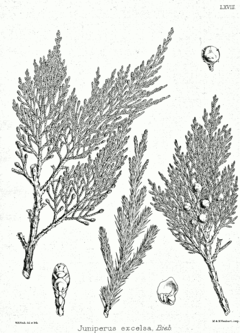Juniperus excelsa
| Juniperus excelsa | |
|---|---|
 | |
| J. excelsa subsp. polycarpos[1] | |
| Scientific classification | |
| Kingdom: | Plantae |
| Division: | Pinophyta |
| Class: | Pinopsida |
| Order: | Pinales |
| Family: | Cupressaceae |
| Genus: | Juniperus |
| Species: | J. excelsa |
| Binomial name | |
| Juniperus excelsa M.Bieb. | |
Juniperus excelsa, commonly called the Greek juniper, is a juniper found throughout the eastern Mediterranean, from northeastern Greece and southern Bulgaria across Turkey to Syria and Lebanon, and the Caucasus mountains.
A subspecies, J. excelsa subsp. polycarpos, known as the Persian juniper, occurs in the Alborz and other mountains of Iran east to northwestern Pakistan, and an isolated population in the Jebal Akhdar mountains of Oman; some botanists treat this as a distinct species Juniperus polycarpos, syn. J. macropoda.
Description
Juniperus excelsa is a large shrub or tree reaching 6–20 metres (20–66 ft) tall (rarely 25 metres (82 ft)). It has a trunk up to 2 metres (6.6 ft) in diameter, and a broadly conical to rounded or irregular crown. The leaves are of two forms, juvenile needle-like leaves 8–10 mm long on seedlings, and adult scale-leaves 0.6–3 mm long on older plants.
It is largely dioecious with separate male and female plants, but some individual plants produce both sexes. The cones are berry-like, 6–11 mm in diameter, blue-black with a whitish waxy bloom, and contain 3-6 seeds; they are mature in about 18 months. The male cones are 3–4 mm long, and shed their pollen in early spring.
It often occurs together with Juniperus foetidissima, being distinguished from it by its slenderer shoots 0.7-1.3 mm diameter (1.2–2 mm diameter in J. foetidissima), and grey-green, rather than mid green, leaves.
The Algum wood mentioned in the Bible may be from this species, but is not definitely so.
References
- ↑ 1874 illustration from plate 68 of D. Brandis, Illustrations of the Forest Flora of North-West and Central India, 1874
- Conifer Specialist Group (1998). "Juniperus excelsa". IUCN Red List of Threatened Species. Version 2006. International Union for Conservation of Nature. Retrieved 12 May 2006.
- Adams, R. P. (2004). Junipers of the World: The genus Juniperus. Victoria: Trafford. ISBN 1-4120-4250-X.
- Farjon, A. (2005). Monograph of Cupressaceae and Sciadopitys. Royal Botanic Gardens, Kew. ISBN 1-84246-068-4.
- Gymnosperm Database: Juniperus excelsa
- photo of tree in southwest Turkey
External links
- EUFORGEN species page on Juniperus excelsa Information, genetic conservation units and related resources
| Wikimedia Commons has media related to Juniperus excelsa. |
